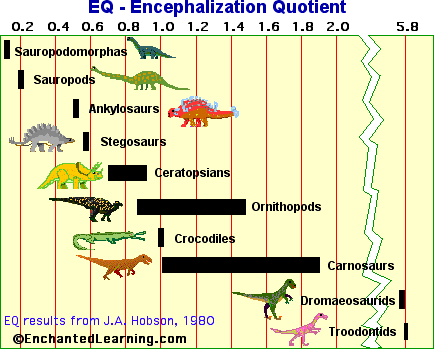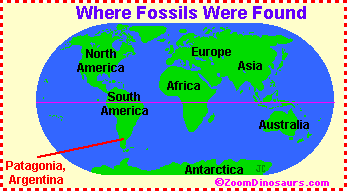Advertisement.
EnchantedLearning.com is a user-supported site.
As a bonus, site members have access to a banner-ad-free version of the site, with print-friendly pages.
Click here to learn more.
(Already a member? Click here.)
AMARGASAURUS
 |
AMARGASAURUS
"Lizard from La Amarga, Argentina"
|
ANATOMY
Amargasaurus (named from La Armaga, a canyon in Argentina where the fossil was found) was a sauropod from the early Cretaceous period. This plant-eater was about 33 feet (10 m) long and weighed roughly 5000 kg. It had 2 rows of spines growing out along its backbone along its neck, body, and tail. These spines may have had a covering of skin forming a sail (or two). If so, this sail might have been a thermoregulatory structure, used to absorb and release heat, for mating and dominance rituals, and/or for making it look much larger than it was to predators. Otherwise, the spines may have been useful as protection. Amargasaurus was a quadruped (it walked on four legs), had a small head, a long neck and a very long tail.
Its front legs were shorter than its back legs, and all the legs had elephant-like, five-toed feet. One toe on each foot had a thumb claw, probably for protection. It may have used its whip-like tail for protection.
DIET
Amargasaurus was an herbivore (it ate only plants). It must have eaten a large amount of plant material each day to sustain itself. It swallowed leaves whole, without chewing them, and may have had gastroliths (stomach stones) in its stomach to help digest this tough plant material. It had blunt teeth, useful for stripping foliage.
Its main food was probably conifers, which were the dominant plant when the large sauropods lived. Secondary food sources may have included Gingkos, seed ferns, cycads, bennettitaleans, ferns, club mosses, and horsetails.
BEHAVIOR
Amargasaurus may have travelled in herds and may have migrated when they depleted their local food supply, like other diplodocids. Amargasaurus probably hatched from eggs like other sauropods. Sauropod eggs (from other species, not Amargasaurus) have been found in a linear pattern and not in nests; presumably the eggs were laid as the animal was walking. It is thought that sauropods did not take care of their eggs. Sauropod life spans may have been on the order of 100 years.
LOCOMOTION
Amargasaurus was a quadruped - it walked on four short legs.
INTELLIGENCE
It used to be thought that the sauropods (like Amargasaurus, Supersaurus, Brachiosaurus and Apatosaurus) and Stegosaurus had a second brain. Paleontologists now realize that what they thought was a second brain was an enlargement in the spinal cord in the hip area. This nerve center controlled the animal's hind legs and tail and was larger than the animal's tiny brain.
Amargasaurus was a sauropod, whose intelligence (as measured by its relative brain to body weight, or EQ) was the among the lowest of the dinosaurs.

WHEN IT LIVED
Amargasaurus lived during the early Cretaceous Period, from about 131 to 125 million years ago.
FOSSILS
 Amargasaurus is known from am almost complete skeleton (it is missing the front of the skull and the tail). Amargasaurus was found in La Amarga, a canyon in Argentina. It was name by paleontologists Salgado & José Bonaparte in 1991.
Amargasaurus is known from am almost complete skeleton (it is missing the front of the skull and the tail). Amargasaurus was found in La Amarga, a canyon in Argentina. It was name by paleontologists Salgado & José Bonaparte in 1991.
CLASSIFICATION
Amargasaurus was a large herbivorous dinosaur, a saurischian ("lizard hipped" dinosaur), a sauropodomorph (long-necked, long-tailed plant-eater who walked on four legs), a sauropod (very large herbivore), and a member of the family Diplodocidae (peg-toothed sauropods, which included Apatosaurus, Supersaurus, Seismosaurus, Diplodocus, and others). Amargasaurus is very similar to Dicraeosaurus.
 Information Sheets About Dinosaurs Information Sheets About Dinosaurs
(and Other Prehistoric Creatures) |
Just click on an animal's name to go to that information sheet. If the dinosaur you're interested in isn't here, check the Dinosaur Dictionary or the list of Dinosaur Genera. Names with an asterisk (*) were not dinosaurs.
How to write a great dinosaur report.
For dinosaur printouts, click here.For brief dinosaur fact sheets, click here.
Enchanted Learning®
Over 35,000 Web Pages
Sample Pages for Prospective Subscribers, or click below
Click to read our Privacy Policy
Enchanted Learning Search
|
Search the Enchanted Learning website for:
|
Advertisement.
Advertisement.
Copyright ©1998-2018
EnchantedLearning.com ------ How to cite a web page


